Chapter 2. Periodic Inspections and Adjustments
Chapter 2. Periodic Inspections and Adjustments xjcdadmin Mon, 05/17/2010 - 09:48Introduction and Intervals
Introduction and Intervals xjcdadmin Mon, 05/17/2010 - 09:49INTRODUCTION
This chapter includes all information necessary to perform recommended inspection and adjustments. These preventative maintenance procedures, if followed, will insure more reliable vehicle operation and a longer service life. The need for costly overhaul work will be greatly reduced. This information applies not only to vehicles already in service, but also to new vehicles that are being prepared for sale. Any service technician performing preparation work should be familiar with this entire chapter.
MAINTENANCE INTERVALS CHARTS
Proper periodic maintenance is important. Especially important are the maintenance services related to emissions control. These controls not only function to ensure cleaner air but are also vital to proper engine operation and maximum performance. In the following tables of periodic maintenance, the services related to emissions control are grouped separately.
PERIODIC MAINTENANCE EMISSION CONTROL SYSTEM
|
No. |
Item |
Remarks |
Initial break-in |
Thereafter every |
||
|
1,000 km (600 mil or 1 month |
5.000 km (3,000 mi) or 7 months |
4,000 km (2,500 mi) or 6 months |
8,000 km (5,000 mi) or 12 months |
|||
|
1* |
Cam chain |
Adjust chain tension. |
o |
0 |
O |
|
|
2* |
Valve clearance |
Check and adjust valve clearance when engine is cold. |
o |
O |
||
|
3 |
Spark plugs |
Check condition. Adjust gap/Clean. Replace after initial 13,000 km (8,000 mi) or 18 months and thereafter every 12,000 km (7,500 mi) or 18 months. |
o |
O |
Replace every 12,000 km (7,500 mi) or 18 months |
|
|
4* |
Crankcase ventilation system |
Check ventilation hose for cracks or damage. Replace if necessary. |
o |
o |
||
|
5* |
Fuel line |
Check fuel hose and vacuum pipe for cracks or damage. Replace if necessary. |
o |
O |
||
|
6" |
Exhaust system |
Check for leakage. Retighten as necessary. Replace gasket(s) if necessary. |
o |
O |
||
|
7' |
Carburetor synchronization |
Adjust synchronization of carburetors. |
o |
O |
||
|
8' |
Idle speed |
Check and adjust engine idle speed. Adjust cable free play if necessary. |
o |
o |
||
It is recommended that these items be serviced by a Yamaha dealer or other qualified mechanic.
GENERAL MAINTENANCE/LUBRICATION
|
No. |
Item |
Remarks |
Type |
Initial break-in |
Thereafter every |
|||
|
1,000 km (600 mi) or 1 month |
5,000 km (3,000 mi) or 7 months |
4,000 km (2,500 mi) or 6 months |
8,000 km (5,000 km) or 12 months |
16.000 km (10,000 mi) or 24 months |
||||
|
1 |
Engine oil |
Warm-up engine before draining. |
Refer to page 2-9. |
O |
O |
O |
||
|
2 |
Oil filter |
Replace. |
- |
o |
O |
O |
||
|
3 |
Air filter |
Clean with compressed air. |
- |
O |
O |
|||
|
4* |
Brake system |
Adj uSt free play Front: Replace pads if necessary. Rear: Replace shoes if necessary. |
- |
O |
o |
0 |
||
|
5" |
Clutch |
Adjust free play |
- |
o |
o |
o |
||
|
6 |
Drive chain |
Check chain condition. Adjust and lubricate chain thoroughly. |
Yamaha chain and cable lube or SAE 10W/30 motor oil |
CHECK CHAIN TENSION AND LUBE EVERY 500 km (300 mi). |
||||
|
7* |
Control and meter cable |
Apply chain lube thoroughly. |
Yamaha chain and cable lube or SAE 10W/30 motor oil |
O |
o |
o |
||
|
8 |
A.C. generator |
Replace generator brushes. Replace at initial 13.000 km (8,000 mil and thereafter every 16.000 km 110,000 mi) |
Replace |
|||||
|
9 |
Brake/clutch lever pivot shaft |
Apply chain lube lightly. |
Yamaha chain and cable lube or 10W/ 30 motor oil |
o |
o |
|||
|
10 |
Change/Brake pedal shaft pivot |
Apply chain lube lightly. |
Yamaha chain and cable lube or 10W/ 30 motor oil |
o |
o |
|||
|
11 |
Center and side stand pivots |
Apply chain lube lightly. |
Yamaha chain and cable lube or 10W/ 30 motor oil |
0 |
o |
|||
|
12 |
Front fork oil |
Drain completely. Refill to specification. |
Yamaha fork oil 10 wt or equivalent |
O |
||||
|
13 |
Steering Ball Bearing and races |
Check bearings assembly for looseness. Moderately repack every 16,000 km (10,000 mi). |
Medium weight wheel bearing grease |
o |
o |
Repack |
||
|
14 |
Wheel bearings |
Check bearings for smooth rotation, Replace if necessary. |
_ |
o |
o |
|||
|
15 |
Battery |
Check specific gravity. Check breather pipe for proper operation. |
- |
o |
0 |
|||
It is recommended that these items be serviced by a Yamaha dealer or other qualified mechanic.
Chassis
Chassis xjcdadmin Mon, 05/17/2010 - 10:23Brakes
Brakes xjcdadmin Mon, 05/17/2010 - 10:261. Brake adjustment
a. Front brake lever free play adjustment
The brake can be adjusted by simply adjusting the free play of the brake lever. The piston in the caliper moves forward as the brake pad wears out, automatically adjusting the clearance betweenthe brake pads and brake disc.
CAUTION:
Proper lever free play is essential to avoid excessive brake drag.

1. Adjuster 2. Lock nut a. 5 — 8 mm (0,2 ~ 0.3 in)
1) Loosen the adjuster lock nut on the brake lever.
2) Turn the adjuster so that the brake lever movement at the lever end is 5 ~ 8 mm {0.2 ~ 0.3 in) before the adjuster contacts the master cylinder piston.
3) After adjusting, tighten the lock nut.
b. Rear brake pedal height adjustment
1) Loosen the adjuster lock nut (for pedal height).
2) By turning the adjuster bolt clockwise or counterclockwise, adjust the brake pedal position so that its top end is approximately 20 mm (0.78 in) below the foot rest top end.
3) Secure the adjuster lock nut.
WARNING:
After adjusting the pedal height, the brake pedal free play should be adjusted.

1. Adjuster bolt 3. Footrest
(for pedal height) 4. Pedal height 20 mm (0.8 in)
2. Lock nut 5. Free play 20 — 30 mm (0.8—1.2 in)
c. Rear brake pedal free play adjustment
Turn the adjuster on the brake rod clockwise or counterclockwise to provide the brake pedal end with a free play of 20— 30 mm (0.8- 1.2 in).
NOTE:
Check to see whether or not the brake light operates correctly after adjusting.
2. Front brake pad and rear brake shoe check
a. Front brake pad
To check, look at the pad wear indicator in back of the caliper. If any pad is worn to the wear limit, replace both the pads in the caliper. Front

1. Wear indicator
b. Rear brake shoe
To check, see the wear indicator position while depressing the brake pedal. If the indicator reaches to the wear limit line, replace the shoes.

1. Wear limit 2, Wear indicator
3. Brake fluid
Insufficient brake fluid may allow air to enter the brake system, possibly causing the brake to become ineffective. Check the brake fluid level and replenish when necessary observing these precautions:

1. Lower level
a. Use only the designated quality brake fluid; otherwise, the rubber seals may deteriorate, causing leakage and poor brake performance.
Recommended brake fluid: DOT#3
b. Refill with the same type and brand of brake fluid; mixing fluids may result in a harmful chemical reaction and lead to poor performance.
c. Be careful that water or other contamination does not enter the master cylinder when refilling. Water will significantly lower the boiling point and may result in vapor lock.
d. Brake fluid may erode painted surfaces or plastic parts. Always clean up spilled fluid immediately.
Drive Chain and Wheels
Drive Chain and Wheels xjcdadmin Mon, 05/17/2010 - 10:29Drive chain
1. Drive chain tension check
NOTE:
Before checking and/or adjusting, rotate the rear wheel through several revolutions and check the tension several times to find the tightest point. Check and/or adjust chain tension with rear wheel in this "tight chain" position.
Inspect the drive chain with the center stand put up. Check the tension at the position shown in the illustration. The normal vertical deflection is approximately 35- 40 mm (1.4 ~ 1.6 in). If the deflection exceeds 35 ~ 40 mm (1.4~1.6 in) adjust the chain tension.

a. 35*^40 mm (1.4**-1.6 in
2. Drive chain tension adjustment
1. Loosen the rear brake adjuster.
2. Remove the cotter pin of the rear wheel axle nut with pliers.
3. Loosen the rear wheel axle nut.
4. Loosen the adjust bolt lock nuts on each side. To tighten the chain turn chain puller adjust bolts clockwise. To loosen the chain turn adjust bolts counterclockwise and push wheel forward. Turn each bolt exactly the same amount to maintain correct axle alignment (There are marks on each side of rear arm and on each chain puller; use them to check for proper alignment).

1. Lock nut 2. Adjuster 3. Marks for align 4. Rear wheel axle nut 5. Cotter pin
5. After adjusting, be sure to tighten the lock nuts and the rear wheel axle nut.
6. Insert the cotter pin into the rear wheel axle nut and bend the end of the cotter pin as shown in the illustration (if the nut notch and the cotter pin hole do not match tighten the nut slightly to match).

CAUTION:
Always use a new cotter pin on the rear axle nut.
NOTE:
Excessive chain tension will overload the engine and other vital parts; keep the tension within the specified limits.
7. In the final step, adjust the play in the brake pedal.
3. Drive chain lubrication The chain consists of many parts which work against each other. If the chain is not maintained properly, it will wear out rapidly. Without lubrication the chain could wear out within 500 km (300 mi), therefore, form the habit of periodically servicing the chain. This service is especially necessary when riding in dusty conditions.
1. Use YAMAHA CHAIN/CABLE LUBE or any of the many brands of spray type chain lubricant. First, remove dirt and mud from the chain with a brush or cloth and the spray the lubricant between both rows of side plates andon all center rollers. This should be performed every 500 km (300 mi).
2. To clean the entire chain, first remove the chain from the motorcycle, dip it in solvent and clean out as much dirt as possible. Then take the chain out of the solvent and dry it. After drying lubricate the chain to prevent the formation of rust.
Tubeless tires and aluminum wheels
This motorcycle is equipped with aluminum wheels designed to be compatible with either tube or tubeless tires. Tubeless tires are installed as standard equipment.
WARNING:
Do not attempt to use tubeless tires on a wheel designed for use only with tube-type tires. Tire failure and personal injury may results from sudden deflation.
Tube-type Wheel — Tube-type tires only
Tubeless-type Wheel — Tube-type or Tubeless tires When using tube-type tires, be sure to install the proper tube also.
Tubeless tire

Tube-type tire

To insure maximum performance, long service, and safe operation, note the following precautions:
1. Check tire pressure, before riding, adjust as necessary.
2. Before operation, always check the tire surfaces for wear and/or damage; look for cracks, glass, nails, metal fragments, stones, etc. Correct any such hazard before riding.
3. Always inspect the aluminum wheels before a ride. Place the motorcycle on the center stand and check for cracks, bends or warpage of the wheels. Do not attempt even small repairs to the wheel. If a wheel is deformed or cracked, it must be replaced.
4. Tires and wheels should be balanced whenever either one is changed or replaced. Failure to have a wheel assembly balanced can result in poor performance, adverse handling characteristics, and shortened tire life.
5. After installing a tire, ride conservatively to allow the tire to seat itself on the rim properly. Failure to allow proper seating may cause tire failure resulting in damage to the motorcycle and injury to the rider.
6. After repairing or replacing a tire, check to be sure the valve stem lock nut is securely fastened. If not, torque it as specified.
Tightening torque: 0.15 m-kg (1.1 ft-lb)
Fuel Petcock
Fuel Petcock xjcdadmin Mon, 05/17/2010 - 10:24

If the fuel petcock is
leaking or excessively contaminated, it should be removed from the fuel
tank and inspected.
1.
Remove the fuel tank and position it so that fuel will not spill when
the petcock is removed.
2.
Remove the petcock and inspect the filter screen. Replace the filter if
seriously contaminated.
3.
Remove the screws on the front and rear of the petcock and remove
the plate, gasket, lever, and diaphragm.
4.
Inspect all components and
replace any that are damaged. If the diaphragm is in any way damaged,
or the petcock body gasket surfaces scratched or corroded, the petcock
assembly must be replaced. If there is abrasive damage to any
component, the fuel tank must be drained and flushed.
5.
Reassemble the petcock and install it on the fuel tank.
Lubrication Points
Lubrication Points xjcdadmin Mon, 05/17/2010 - 10:37Cable inspection and lubrication
WARNING:
Damage to the outer housing of the various cables, may cause corrosion and often free movement will be obstructed. An unsafe condition may result so replace such cables as soon as possible.
1. If the inner cables do not operate smoothly, lubricate or replace them.
Recommended lubricant:
Yamaha Chain and Cable Lube or
SAE 10W/30 motor oil
I. Throttle cable and grip lubrication
The throttle twist grip assembly should be greased when the cable is lubricated, since the grip must be removed to get at the end of the throttle cable. Two screws clamp the throttle housing to the handlebar. Once these two are removed, the end of the cable can be held high to pour in several drops of lubricant. With the throttle grip disassembled, coat the metal surface of the grip assembly with a suitable all-purpose grease to cut down friction.
Brake and change pedal/brake and clutch levers
Lubricate the pivoting parts of each lever and pedal.
Recommended lubricant:
Yamaha Chain and Cable Lube or SAE 10W/30 motor oil
Center and side stand pivots
Lubricate the center and side stands at their pivot points.
Recommended lubricants:
Yamaha Chain and Cable Lube or SAE 10W/30 motor oil
Suspension and Steering
Suspension and Steering xjcdadmin Mon, 05/17/2010 - 10:33Front fork oil change
WARNING:
Securely support the motorcycle so there is no danger of it falling over.
1. Raise the motorcycle or remove the front wheel so that there is no weight on the front end of the motorcycle. Remove the handlebar if necessary.
2. Remove the rubber cap from the top of each fork.
3. The spring seat and fork spring are retained by a stopper ring (spring wire circlip). it is necessary to depress the spring seat and fork spring to remove the stopper ring. Remove the stopper ring by carefully prying out one end with a small screwdriver,

4. Place an open container under each drain hole. Remove the drain screw from each outer tube.
WARNING:
Do not allow oil to contact the disc brake components. If any oil should contact the brake components it must be removed before the motorcycle is operated. Oil will cause diminished braking capacity and will damage the rubber components of the brake assembly.

1. Drain screw
5. When most of the oil has drained, slowly raise and lower the outer tubes to pump out the remaining oil.
6. Inspect the drain screw gasket. Replace if damaged. Reinstall the drain screw.
7. Pour the specified amount of oil into the fork inner tube.
Front fork oil (each fork):
230 cc (7.78 oz) Recommended oil:
Yamaha Fork Oil 10 wt or equivalent
8. After filling, slowly pump the forks up and down to distribute the oil.
9. Inspect the "O-ring" on the spring seat. Replace "O-ring" if damaged.
10. Reinstall the spring seat, stopper ring and rubber cap.
CAUTION:
Always use a new stopper ring (spring wire circlip).
F. Rear shock absorber
If the spring seat is raised, the spring becomes stiffer and if lowered, it becomes softer.
Standard position................A
A. position.................Softest
E. position................ Stiffest

Steering head adjustment
The steering assembly should be checked periodically for looseness.
1. Raise the front end of the motorcycle so that there is no weight on the front wheel.
2. Grasp the bottom of the forks and gently rock the fork assembly backward and forward, checking for looseness in the steering assembly bearings.

3. If there is looseness in the steering head, loosen the steering stem and front fork pinch bolts and steering fitting bolt.
4. Use a steering nut wrench to loosen steering fitting nut.
5. Tighten the steering fitting nut until the steering head is tight, but does not bind when forks are turned.
6. Retighten the steering fitting nut, steering fitting bolt and steering stem and front fork pinch bolts, in that order.
7. Recheck steering adjustment to make sure there is no binding when the forks are moved from lock to lock. If necessary, repeat adjustment procedure.
Electrical
Electrical xjcdadmin Mon, 05/17/2010 - 10:39Battery
Battery xjcdadmin Mon, 05/17/2010 - 10:40A. Battery
1. The fluid level should be between the upper and lower level marks. Use only distilled water if refilling is necessary.
CAUTION:
Normal tap water contains minerals which are harmful to a battery; therefore, refill only with distilled water.
2. Always make sure the connections are correst when installing the battery. Make sure the breather pipe is properly connected, properly routed, and is not damaged or obstructed.

CAUTION:
The battery must be charged before using to insure maximum performance. Failure to properly charge the battery before first use, or low electrolyte level will cause premature failure of the battery. Charging current: 1.2 amps/10 hrs or until the specific gravity reaches 1.280 at 20°C (68°F)
WARNING:Battery electrolyte is poisonous and dangerous, causing severe burns, etc. It contains sulfuric acid. Avoid contact with skin, eyes or clothing. Antidote:
EXTERNAL-Flush with water.
INTERNAL—Drink large quantities of water or milk. Follow with milk of magnesia, beaten egg or vegetable oil. Call physician immediately.
Eyes:
Flush with water for 15 minutes and get prompt medical attention. Batteries produce explosive gases. Keep sparks, flame, cigarettes, etc. away. Ventilate when charging or using in closed space. Always shield eyes when working near batteries. KEEP OUT OF REACH OF CHILDREN.
Headlight and Taillight
Headlight and Taillight xjcdadmin Mon, 05/17/2010 - 10:44Headlight
1. Headlight bulb replacement

a. Remove the cowling assembly.

b. Remove the 2 screws holding the light unit assembly to the headlight body.

c. Disconnect the lead wires and remove the light unit assembly.

d. Remove the top and bottom fitting screws and the horizontal adjusting screw. Remove the light unit assembly from the headlight rim.

e. Remove the sealed beam unit holding screws. Remove the unit retaining ring and the defective unit.
f. Slip a new sealed beam unit into position and secure it with the retaining ring and install it into the headlight rim.
g. Reinstall the light unit assembly to the headlight body. Adjust the hedalight beam.
h. Reinstall the cowling assembly.
2. Headlight beam adjustment
a. Horizontal the beam to the right, turn the adjusting screw clockwise. To adjust the beam to the left, turn the screw counterclockwise.
b. Vertical adjustment:
Loosen the adjusting screw under the headlight body. Adjust vertically by moving the headlight body. When proper adjustment is determined, retighten the adjusting screw.

a. Horizontal adjusting screw
b. Vertical adjusting screw
Taillight
1. Taillight bulb replacement
a. Open the seat.
b. Pull open the lid in the seat cowl.
c. To remove the bulb, turn it approxi matety 30° counterclockwise.

1.Lid 2. Bulb
d. To install the bulb, reverse the removal procedure.
Spark Plug
Spark Plug xjcdadmin Mon, 05/17/2010 - 10:411. Check the electrode condition and wear, insulator color and electrode gap.
2. Use a wire gauge for measuring the plug gap.
3. If the electrodes become too worn, replace the spark plug.
4. When installing the plug, always clean the gasket surface. Wipe off any grime that might be present on the surface of the spark plug, and torque the spark plug properly.
Standard spark plug: D8EA (NGK) or X24ES-U (ND)
Spark plug gap: 0.6-0.7 mm (0.024 ~ 0.028 in)
Spark plug tightening torque: 2.0 m-kg (14.5 ft-lb)
Engine
Engine xjcdadmin Mon, 05/17/2010 - 09:50Air Cleaner
Air Cleaner xjcdadmin Mon, 05/17/2010 - 10:061. Removal
a. Open the seat.
b. Remove the side cover (left).
c. Remove the air cleaner case cover by removing the four screws.

d. Pull out the element.

I. Air filter element
2. Cleaning method
Tap the element lightly to remove most of the dust and dirt; then blow out the remaining dirt with compressed air from the inner surface of the element. If element is damaged, replace it.

3. Reassemble by reversing the removal procedure. Check whether the element is seated completely against the case.
4. The air cleaner element should be cleaned at the specified intervals.
CAUTION:
The engine should never be run without the air cleaner element installed; excessive piston and/or cylinder wear may result.
Cam Chain Adjustment
Cam Chain Adjustment xjcdadmin Mon, 05/17/2010 - 10:02The cam chain becomes stretched with use, resulting in improper valve timing and engine noise. To prevent this, the cam chain ten-sioner must be adjusted regularly.
1. Remove the timing plate cover.
2. Slowly rotate the crankshaft counterclockwise until the "C" mark on the timing plate aligns with the stationary pointer.

3. Loosen the tensioner lock nut and then loosen the stopper bolt. This releases the cam chain tensioner with the proper tension.

1. Lock nut 2. Stopper bolt
4. Tighten the stopper bolt and lock nut.
Stopper bolt torque: 0.6 m-kg (4.3 ft-lb) Lock nut torque: 0.9 m-kg (6.5 ft-lb)
5. Reinstall the timing plate cover.
Carburetor
Carburetor xjcdadmin Mon, 05/17/2010 - 10:08NOTE:
The carburetors are numbered 1, 2, 3, and 4 from the left when viewed from astride the motorcycle.
1. Idle mixture
The idle mixture is set at the factory by the use of special equipment. No attempt should be made by the dealer to change this adjustment.
2. Synchronization
The seat must be opened and the rear of the tank elevated to gain access to the vacuum connections and synchronizing screw of the carburetors.
NOTE:
The valve clearances must be set properly before synchronizing the carburetors.
a. Remove the vacuum pipe from the carburetor manifold (No. 2 cylinder) and turn the fuel petcock to "PRI".
b. Remove the rubber caps from the No. 1, 3, and 4 carburetor manifolds.

1, Vacuum pipe 2. Rubber cap
c. Remove either the left or right (but not both) blind plug at the end of the YICS (Yamaha Induction Control System) passage in the cylinder.
d. Insert the YICS shutoff tool (special tool) fully and flip the locking lever.
e. Connect each vacuum gauge hose to its proper carburetor.

1. Vacuum gauge
f. Start the engine allow it to warm-up for a few minutes. The warm-up is complete when engine responds normally to the throttle opening.
g. Make sure the engine idle speed is 1,000 ~~ 1,100 r/min. If it does not, adjust the idle speed with the throttle stop screw.
NOTE:
With the YICS shutoff tool fitted, the engine speed generally drops a little. Thus, continue with the following steps at idle speed of 1,000~ 1,100 r/min.
h. Each gauge reading will indicate the same if the carburetors are synchronized. The No. 3 carburetor has no synchronizing screw and the other carburetors are to be synchronized to it in order, one at a time.
First, synchronize carburetor No. 1 to carburetor No. 2 by turning the No. 1 synchronizing screw until both gauges read the same.
Second, in the same way synchronize carburetor No. 4 to carburetor No. 3. Third, by adjusting No. 2 screw to watch No. 3 carburetor reading, No. 1 and No.2 carburetors will both change to match No. 3 carburetor.

1. Synchronizing screws
i. Make sure that the engine now develops an idle engine speed of 1,000 ~ 1,100 r/min. If it does not, adjust the idle speed with the throttle stop screw and repeat the steps starting with g.
j. Remove the YICS shutoff tool and reinstall the blind plug.
Tightening torque:
2.2m-kg (16.0ft-lb)
3. Idle speed adjustment
NOTE:
Carburetors must be synchronized before setting final idle speed. The idle speed adjustment is made by turning only one throttle stop screw.
a. The engine must be warmed up before setting idle speed.
b. Set the engine idle speed by turning the throttle stop screw in (to increase engine speed) or out (to decrease engine speed).
Standard idle speed: 1,200 r/min

1. Throltle stop screw
Clutch Adjustment
Clutch Adjustment xjcdadmin Mon, 05/17/2010 - 10:21Free play adjustment
a. Loosen either the handlebar lever adjuster lock nut or the cable length adjuster lock nut.
b. Turn the cable length adjuster either in or out until proper lever free play is achieved.
Clutch lever free play:
2 - 3mm (0.08 ~ 0.12 in)

1, Lock nut 2. Adjuster a. 2 — 3 mm (0.08— 0.12 \n)

1. Lock nut 2. Adjuster
Compression
Compression xjcdadmin Mon, 05/17/2010 - 10:19Insufficient compression pressure will result in performance loss and may indicate leaking valves or worn or damaged piston rings. Procedure:
1. Make sure the valve clearance is correct.
2. Warm up the engine 2^3 minutes.
3. Remove all the spark plugs.
4. Install a compression check gauge.
5. Turn over the engine with the electric starter (make sure the battery is fully charged) with the throttle wide open until the pressure indicated on the gauge does not increase further.
Compression pressure (at sea level):
Standard ............ 8.5 kg/cm2(121 psi)
Minimum............ 7.0 kg/cm2(100 psi)
Maximum .......... 9.5 kg/cm2(135 psi)
WARNING:
When cranking the engine, ground the removed spark plug wires to prevent sparking.

1. Compression gauge
6. If the pressure is too low, squirt a few drops of oil into the cylinder being measured. Measure compression again. If there is a higher reading than before (without oil), the piston rings may be worn or damaged. If the pressure remains the same after measuring with the oil, either or both the rings and valves may be the cause.
7. Check each cylinder. Compression pressure should not vary more than specified value from one cylinder to any other cylinder.
Difference in gauge reading: Less than 1 kg/cm2 (14 psi)
Engine Oil
Engine Oil xjcdadmin Mon, 05/17/2010 - 10:111. Oil level measurement a. Place the motorcycle on the center stand, Warm up the engine for several minutes.
NOTE:
Be sure the motorcycle is positioned straight up when checking the oil level; a slight tilt toward the side can produce false readings.
b. With the engine stopped, check the oil level through the level window located at the lower part of the right side crank-case cover.
NOTE:
Wait a few minutes until the oil level settles before checking.

1. Maximum mark 2- Minimum mark 3. Level window
c. The oil level should be between maximum and minimum marks. If the level is lower add sufficient oil to raise it to the proper level.
2. Engine oil and oil filter replacement
a. Start the engine and stop it after a few minutes of warm-up.
b. Place an oil pan under the engine and remove the oil filler cap.
c. Remove the engine drain plug and drain the oil.

1. Engine drain plug
d. Remove the oil filter bolt and filter element.

1. Oil filter cover
e. Re-install the drain plug (make sure it is tight).
Drain plug torque: 4.3 m-kg (31.0 ft-lb)
f. Install the new oil filter element, new "O-ring" and filter cover, and tighten the oil filter bolt.
Oil filter bolt torque: 1.5 m-kg (11.0 ft-lb)
NOTE:
When installing the filter cover, make sure the "O-ring" is positioned properly and insert the locating projection on it into the corresponding guides on the crankcase.

1. Proper O-ring position
g. Add oil through the oil filler hole.
CAUTION:
Take care not to allow foreign material to enter the crankcase.
Periodic oil change: 2.2 lit (2.3 US qt.)
With oil filler replacement: 2.5 lit (2.6 US qt.)
Recommended oil:


h. After replacement of the engine oil and/ or oil filter, be sure to check for oil leakage. The oil level indicator light should go off after the engine has started.
CAUTION:
If the indicator light flickers or remains on, the oil level switch may be damaged. Refer to "CHAPTER 6" for corrective action.
Ignition Timing
Ignition Timing xjcdadmin Mon, 05/17/2010 - 10:041. Ignition timing is checked with a timing light by observing the position of the stationary pointer and the marks stamped on the timing plate.
The timing plate is marked as follows:
"n"— Firing range for No. 1 (L.H.) cylinder
"T" ....Top Dead Center for No. 1 (L.H.) and No. 4 (R.H.) cylinders.
2. Connect the timing light to No. 1 (L.H.) spark plug lead wire.
3. Start the engine and keep the engine speed as specified. Use a tachometer to check the engine speed.
Specified engine speed: 1,200 r/min
4. The stationary pointer should be within the limits of " n " on the timing plate. If it exceeds the limits or does not steady, check the timing plate for tightness and/or ignition system for damage. (See "CHAPTER 6. ELECTRICAL)
CAUTION:
Never bend the stationary pointer.

Valve Clearance Adjustment
Valve Clearance Adjustment xjcdadmin Mon, 05/17/2010 - 09:59A. Valve clearance adjustment
NOTE:
Valve clearance must be measured with the engine and at room temperature.
1. Open the seat and remove the fuel tank.
2. Remove the flasher relay and spark plug lead wires.

Remove the cylinder head cover and left crankcase cover (pick-up base cover). Care should be taken to not scratch or damage the gasket sealing surfaces. Turn the crankshaft with the nut on the left end of the crankshaft to turn the cams. The proper position of the cam when measuring the valve clearance is with the cam lobe directly opposite the valve lifter,

5. Insert a feeler gauge between the valve lifter and the camshaft base circle.

Intake valve clearance (cold):
0.11-0.15 mm (0.004-0.006in)
Exhaust valve clearance (cold):
0.16-0.20 mm (0.006-0.008 in)
Adjustment
Valve clearance is adjusted by replacing the adjusting pad on the top of the valve lifter. Adjusting pads are available in 25 thicknesses ranging from No. 200 (2.00 mm) to No. 320 (3.20 mm) in steps of 0.05 mm. The thickness of each pad is marked on the pad face that contacts the valve lifter (not the cam). Adjustment of the valve clearance is accomplished as follows:
1. Determine valve clearance (feeler gauge measurement.)
2. Remove adjusting pad and note number.
3. Selectproper pad from appropriate chart (intake or exhaust chart).
4. Install new pad and check installed clearance.
Procedure
1. Measure valve clearance. If clearance is incorrect, record the measured amount of clearance. This must be measured carefully.
2. There is a slot in the valve lifter. This slot must be positioned opposite the blade of the tappet adjusting tool before the tool is installed.
3. Turn the cam until the lobe fully depresses the valve lifter and opens the valve. Install the tappet adjusting tool as shown tohold the lifter in this depressed position.
NOTE:
The tappet adjusting tool is fastened to the cylinder head securely using an alien screw. Make sure that the tool contacts the lifter only, and not the pad.
CAUTION:
If the cam lobe touches the tappet adjusting tool, the stress may fracture the cylinder head. DO NOT ALLOW THE CAM LOBE TO CONTACT THE TAPPET ADJUSTING TOOL.


1. Tappet adjusting tool 2. Adjusting pad
4. Carefully rotate the cam so that the pad can be removed. To avoid cam touching the adjusting tool, turn cams as follows: (view from left side of the motorcycle) Intake: Carefully rotate CLOCKWISE. Exhaust: Carefully rotate COUNTERCLOCKWISE.

5. Remove the pad from the lifter. There is a slot in the lifter. Use a small xrew-driver or other blade and tweezers or a magnetic rod to remove the pad. Note the number on the pad.

1. Adjusting pad
6 Proper pad selection is made as follows:
Chart lookup method:
Refer to the appropriate chart for exhaust or intake valves:
0.11 to 0.15mm required clearance (Intake side) chart
0.15 to 0.20mm required clearance (Exhaust side) chart
a. Find number of original (installed) pad number on chart. Read down on chart.
b. Find measured valve clearance (from step 1) on chart. Read across.
c. At the intersection of installed pad number (down) and measured clearance (across) is a new pad number.
EXAMPLE:
Intake valve, installed pad: No. 250 (read down)
Measured clearance:0.32 mm (read across)
New pad number: No. 270(intersection of down & across)
Alternate shim calculation method:
Since all shims come in .05mm (.002") increments, you can quickly calculate the required size without a chart.
If the measured clearance is within 0.05mm (0.002") of the required clearance, then no change is needed.
If the measured clearance greater than 0.05mm (0.002") but 0.10mm (0.004") or less different than the required clearance then the next size shim is required.
If the measured clearance greater than 0.10mm (0.004") but 0.15mm (0.006") or less different than the required clearance then the next size shim is required.
Clearances that are too small require thinner shims. Clearances that are too large require thicker shims.
Example: Required exhaust valve clearance is 0.16~0.20mm. Measured clearance is 0.12mm (gap too small). Installed shim is Y270. Required shim is one size thinner: Y265.
| Attachment | Size |
|---|---|
| 11-15mm_valve_shim_chart.xls | 20 KB |
| 16-20mm_valve_shim_chart.xls | 18.5 KB |